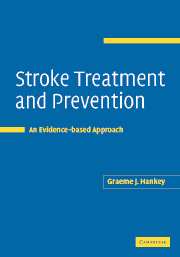Book contents
- Frontmatter
- Contents
- Preface
- 1 The size of the problem of stroke
- 2 Understanding evidence
- 3 Organised acute stroke care
- 4 General supportive acute stroke care
- 5 Reperfusion of ischaemic brain by thrombolysis
- 6 Augmentation of cerebral blood flow: fibrinogen-depleting agents, haemodilution and pentoxifylline
- 7 Neuroprotection
- 8 Treatment of brain oedema
- 9 Anticoagulation
- 10 Antiplatelet therapy
- 11 Carotid artery revascularisation
- 12 Lowering blood pressure
- 13 Lowering blood cholesterol concentrations
- 14 Modification of other vascular risk factors and lifestyle
- 15 Antithrombotic therapy for preventing recurrent cardiogenic embolism
- 16 Arterial dissection and arteritis
- 17 Treatment of intracerebral haemorrhage
- 18 Treatment of subarachnoid haemorrhage
- References
- Index
7 - Neuroprotection
Published online by Cambridge University Press: 23 December 2009
- Frontmatter
- Contents
- Preface
- 1 The size of the problem of stroke
- 2 Understanding evidence
- 3 Organised acute stroke care
- 4 General supportive acute stroke care
- 5 Reperfusion of ischaemic brain by thrombolysis
- 6 Augmentation of cerebral blood flow: fibrinogen-depleting agents, haemodilution and pentoxifylline
- 7 Neuroprotection
- 8 Treatment of brain oedema
- 9 Anticoagulation
- 10 Antiplatelet therapy
- 11 Carotid artery revascularisation
- 12 Lowering blood pressure
- 13 Lowering blood cholesterol concentrations
- 14 Modification of other vascular risk factors and lifestyle
- 15 Antithrombotic therapy for preventing recurrent cardiogenic embolism
- 16 Arterial dissection and arteritis
- 17 Treatment of intracerebral haemorrhage
- 18 Treatment of subarachnoid haemorrhage
- References
- Index
Summary
Rationale
Normally, cerebral blood flow (CBF) is maintained by cerebral autoregulation at about 50 ml blood/100 g brain/min.
In acute ischaemic stroke, a cerebral artery is occluded or there is a reduction in perfusion distal to a severe stenosis, resulting in focal brain ischaemia and infarction. As the regional CBF falls, the regional lack of oxygen and glucose results in a time- and flow-dependent cascade characterised by a fall in energy (adenosine triphosphate, ATP) production. Neuronal function is affected in two stages. The first threshold is at a blood flow of about 20 ml blood/100 g brain/min, below which neuronal electrical function is compromised, but is recoverable. If blood flow falls below the second critical threshold of 10 ml blood/100 g brain/min, there is excessive release from pre-synaptic vesicles, and impaired reuptake, of excitatory amino acid (EAA) neurotransmitters such as glutamate. Neuronal glutamate receptors are overstimulated (excitotoxicity), free radicals are generated, spreading damage occurs, aerobic mitochondrial metabolism fails, inefficient anaerobic metabolism of glucose takes over, and lactic acidosis evolves. Energy-dependent homoeostatic mechanisms of maintaining cellular ions fail, potassium leaks out of cells, and sodium, water and calcium enters cells leading to cytotoxic oedema and calcium-induced mitochondrial failure, respectively (Lee et al., 1999). If severe ischaemia (blood flow below 10 ml blood/100 g brain/min) is sustained, irreversible neuronal damage occurs and neuronal cell apoptosis and necrosis ensue.
The recognition of two thresholds of CBF and stages of neuronal failure led to the concept of the ischaemic penumbra as an area of brain surrounding the infarcted core which has reached the reversible stage of neuronal electrical failure (i.e. it is electrically quiescent) but has not passed into the second irreversible stage of failure of cellular homoeostasis.
- Type
- Chapter
- Information
- Stroke Treatment and PreventionAn Evidence-based Approach, pp. 126 - 156Publisher: Cambridge University PressPrint publication year: 2005



